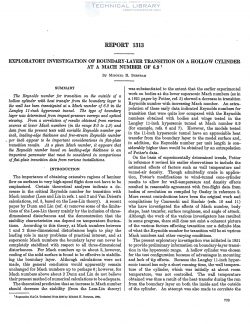naca-report-1313
- Version
- 187 Downloads
- 1.51 MB File Size
- 1 File Count
- November 2, 2016 Create Date
- November 2, 2016 Last Updated
National Advisory Committee for Aeronautics, Report - Exploratory Investigation of Boundary Layer Transition on a Hollow Cylinder at a Mach Number of 6.9

The Reynolds number for transition on the outside of a
hollow cylinder with heat transfer from the boundary layer to
the wall has been investigated at a Mach number of 6.9 in the
Langley 11-inch hypersonic tunnel. The type of boundary
layer was determined from impact~pressure surveys and optical
viewing. From a correlation of results obtained from various
sources at lower Mach numbers (in the range 2.0 to 4.5) and
data from the present tests with variable Reynolds number per
inch, leading—edge thickness and free-stream Reynolds number
. per inch appear to be important considerations in flat-plate
transition results. At a given Mach number, it appears that
the Reynolds number based on leading-edge thickness is an
important parameter that must be considered in comparisons
of flat-plate transition data from various installations.
The importance of obtaining extensive regions of laminar
flow on surfaces in very high-speed flight does not have to be
emphasized. Certain theoretical analyses indicate a de—
crease in the critical Reynolds number for transition with
Mach number (Lees and Lin in refs. 1 and 2 and Van Driest’s
calculations, ref. 3, based on the Lees-Lin theory). A recent
paper by Dunn and Lin (ref. 4) removes some of the limita-
tions of the Lees-Lin theory mainly by the inclusion of three-
dimensional disturbances and the demonstration that the
stability characteristics can depend on temperature fluctua-
tions.
According to this theory, at Mach numbers between
1 and 2 three-dimensional disturbances begin to play the
leading role in many problems of practical interest, and at
supersonic Mach numbers the boundary layer can never be
completely stabilized with respect to all three-dimensional
disturbances. For Mach numbers up to about 2, however,
cooling of the solid surface is found to be effective in stabiliz~
ing the boundary layer. Although calculations were not
made, this general conclusion would apparently remain
unchanged for Mach numbers up to perhaps 6; however, for
Mach numbers above about 2 Dunn and Lin do not believe
their present method of numerical calculations to be adequate.
The theoretical prediction that an increase in Mach number
should decrease the stability (from the Lees-Lin theory)
was substantiated to the extent that the earlier experimental
work on bodies at the lower supersonic Mach numbers (as in
a 1951 paper by Potter, ref. 5) showed a decrease in transition
Reynolds number with increasing Mach number. An extra—
polation of these early data indicated Reynolds numbers for
transition that were quite low compared with the Reynolds
numbers obtained with bodies and wings tested in the
Langley 11~inch hypersonic tunnel at Mach number 6.9
(for example, refs. 6 and 7). However, the models tested
in the 11—inch hypersonic tunnel have an appreciable heat
transfer from the boundary layer to the model surface and,
in addition, the Reynolds number per unit length is con-
siderably higher than would be obtained by an extrapolation
of Potter’s data.
| File | Action |
|---|---|
| naca-report-1313 Exploratory Investigation of Boundary Layer Transition on a Hollow Cylinder at a Mach Number of 6.9.pdf | Download |

Comment On This Post